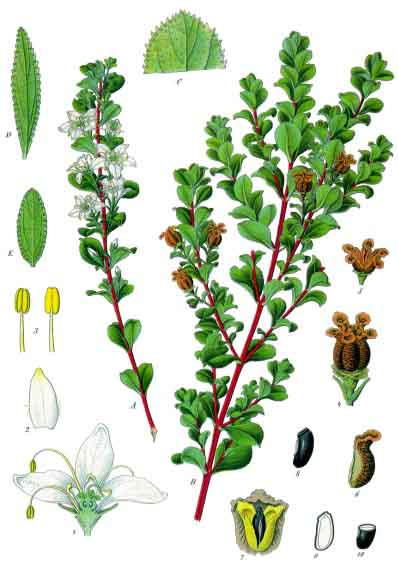
Barosma betulina (Bartl. and Weidl.)
Synonyms: Agathosma betulina (Berg.),
Diosma betulina, bucco, bookoo, bucku, round buchu, short buchu
Order: Rutaceae
Description: Barosma is a small shrub native to the Cape Province, South Africa, and reaches a height of up to 2m. The leaves are 1-2cm long, with a broad tip converging to a very short stem; bright to yellowish green, darker above than below, with papillae on the upper surface marking the presence of oil glands, and very wrinkled on the lower surface. The five-petaled flowers are whitish to pink; the fruit is an ovate capsule.
Parts used: leaves
Collection: the leaves are collected during the flowering and fruiting period.
Constituents: Volatile oil (up to 2.5%, containing diosphenol, limonene and menthol and camphor), Glycoside (barosmin), Flavonoids (including diosmin, rutin, hesperidin, quercetin and derivatives), mucilage, resin, vitamins of the B group, tannin
Actions: urinary antiseptic, diuretic, aromatic, diaphoretic, stimulant
Indications:
Therapeutics and Pharmacology: Barosma may be used in any infection of the genito-urinary system, such as cystitis, urethritis prostatitis and dysuria. Its healing and soothing properties indicate its use together with other relevant remedies in any condition of this system. It is particularly useful in painful and burning urination. The herb's diuretic activity is due to the presence of diosphenol, which may also be antibacterial.
Combinations: Barosma may be combined with Althaea or Zea in genito-urinary conditions with painful micturition and pyuria. In cystitis it may be combined with Achillea or Agropyron..
Caution: There is occasional gastrointestinal intolerance to Barosma so it should not be taken on an empty stomach. It is contraindicated during pregnancy. It may irritate diseased kidneys, and so should be avoided in kidney infections.
Preparation and Dosage: (thrice daily)
GSL, Schedule 1
Dried leaves: 1-2g by infusion
Liquid Extract: 1:1 in 90% alcohol, 0.5-1.5ml
Tincture: 1:5 in 60% alcohol, 2-4ml
Concentrated Buchu infusion (BPC 1954): 1:2.5 in 25% alcohol, 4-8ml
Additional Comments: Two other species are used medicinally - Barosma crenulata (oval Buchu) and B.serratifolia (long Buchu). In South Africa, an infusion of buchu leaves in brandy is drunk as a stomachic and stimulant tonic. The Hottentots used Buchu to perfume their bodies. It was introduced into official medicine in Britain in 1821 as a remedy for cystitis, urethritis, nephritis and catarrh of the bladder.
Bibliography
BHMA 1983 British Herbal Pharmacopoeia, BHMA, Bournemouth
Bradley, P.R. (ed.) 1992 British Herbal Compendium, Volume 1, BHMA, Bournemouth.
Grieve, M. 1931 A Modern Herbal, (ed. C.F. Leyel 1985), London.
Hoffmann, D. 1990 The New Holistic Herbal, Second Edition, Element, Shaftesbury.
Lust, J. 1990 The Herb Book, Bantam, London.
Mabey, R. (ed.) 1991 The Complete New Herbal, Penguin, London.
Mills, S.Y. 1993 The A-Z of Modern Herbalism, Diamond Books, London.
Ody, P. 1993 The Herb Society's Complete Medicinal Herbal, Dorling Kindersley, London.
Polunin, M. and Robbins, C. 1992 The Natural Pharmacy, Dorling Kindersley, London.
Wren, R.C. 1988 Potter's New Cyclopaedia of Botanical Drugs and Preparations, C.W.Daniel, Saffron Walden.










